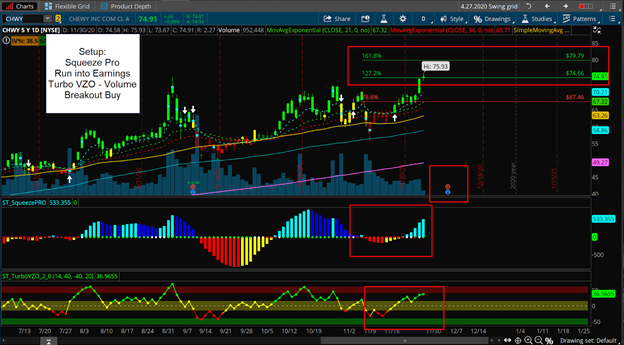With this setup overall, I have one setup and I traded it three ways. That’s why it’s called a stacked profit, explains Danielle Shay of Simpler Trading.
While my original stacked profits strategy was a strategy where I’d use multiple butterflies on one setup to stack my profits, I’ve since modeled the strategy to work for multiple different strategies (not just butterflies).
In this Chewy trade that we’re going to look at, I didn't use multiple butterflies, but I'm still calling it stacked profits because it’s three separate trades on one setup and they all benefited in various ways.
What were those three separate trades?
- A butterfly
- A debit spread
- A long call
These three strategies had different benefits (different positives and different negatives). That’s an advantage to playing multiple different strategies on one trade as opposed to sticking to a single strategy. You get to “stack your profits” and enjoy the different benefits of each strategy.
Overall, the setup was a couple of different things. First off, Chewy (CHWY) has been one of my favorite stocks to trade all year. It’s been a great momentum mover. It's also been a great Covid stock. Number 2, it had a squeeze again. I’ve traded every squeeze in Chewy since around April, but this time I wanted to trade it with a much smaller size.
Why?
Since the news about a possible Covid vaccine has come out, the Covid stocks have been a little bit more volatile and not as great as they had been in the past. For example, there was one recent Monday that all of them were down 15% or so. That wasn’t a super fun Monday. That’s why I wanted to go ahead and trade this but trade it with a low-risk, high-reward approach.
It ended up working out great as I made about $1,000 on a very low-risk trade.
How It Played Out:
I got in with the Squeeze Pro and also the Turbo VZO. We had my favorite signal on the Turbo VZO (a volume breakout signal) to kick it off. Plus, you can see that there’s a bright white candle, which was the entry for the volume breakout on the chart below.

Then I went ahead and took profits right at 127.2 extension (right before Black Friday weekend). In addition to Chewy being a major Covid stock, it’s also a major retail stock. So, I was just a little bit concerned about this. Because it’s found resistance between 70 and 75 multiple times, and it’s had a hard time getting through. I was also concerned the Black Friday sales were going to be a little light this year, so I wanted to be cautious with any of my retail trades going into the weekend.
Now let’s look at specifically the butterfly trade of those three separate trades…
Trade #1: A Butterfly:
On this butterfly I targeted a little bit of a lower target, while the debit spread was targeting a little higher. I did this because I wanted to have a trade that was a bit more conservative because I wasn’t sure that we were going to get all the way to 75. With that being said, this was a conservative butterfly that only cost $1.35, and it was $6 wide (so your max profit would be $6).
Now I still have this trade on, and I’ll explain why that is. It’s going for about $2.23 (so currently it’s not quite a double). The reason is because Chewy blew through the center strike of this butterfly at 70. So, with this one, it was up a little bit more when we were trading below 70, so I decided to keep it one for the next couple of days. Why? Well since Chewy has already traded up to 75, I think we’ll see it find a little bit of resistance and fall a little lower. I’m leaving this trade on through the ebbs and flows, so that the butterfly can mature.
With a butterfly you really need it to mature, which means you need to get it as close to the expiration date and the center strike as possible.
Check back next week for my in-depth walkthrough of the other two trades: a debit spread and a long call, plus how it all played out in terms of profit (since my butterfly is still open)!
To learn more about Danielle Shay, visit SimplerTrading.com.





















